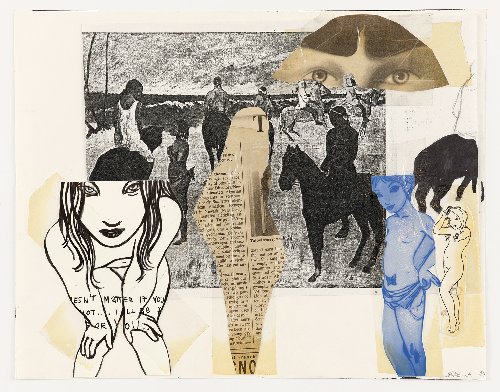|
Inserito il
17 Marzo 2023
Hidden
di Rita Ackermann
Mousse Magazine 2023
Prezzo 30 euro Pagine 128
ISBN:9788867495689

Text by Pamela Kort, a conversation between Rita Ackermann and Donatien Grau
“Things can be freer and reach higher when they conceal themselves.” Rita Ackermann
Published on the occasion of the artist's solo exhibition at the MASI in Lugano, titled Hidden, this book traces the last thirty years of Rita Ackermann’s career containing both well-known and previously unpublished works, ranging from painting to drawing, created in a range of media and formats. Rita Ackermann’s first drawings and paintings, made between 1993 and 1996, show adolescent female figures multiplied within the composition and engaged in various self-destructive activities, expressed to the public through understandable and direct language. Twenty years down the line, Ackermann rethinks the presence of the figure as the focus of her work, endowing it with new connotations and reworking it through a layering of subjects and matter.
(...)What comes from below the surface, and how its traces make themselves known in a work of art, is what matters to Rita Ackermann. Splinters of ideas, fragments of specters, remnants of things bubble up and thereafter metamorphose into the stuff of her images. And then come the veils that illuminate or partly obfuscate them, be they through plays of light, the effacing action of paint, or shapes set off by a shower of color. The latent abstract element in her more figurative images gains the upper hand. Call it what you may—a meditation on eternal returns, a conciliation of representational and abstract manners of working, or a dialogue between emergence and disappearance—one thing is certain. At work just below the threshold of perception is a cinematic manner of looking at the world.
Part One: Origins
At the beginning was a childhood and adolescence lived out between 1968 and 1987 in Budapest, where Ackermann was born. Then there were three years of intense and productive study at the Art Academy there, just as the Soviet Bloc began to crumble and fall. When an offer of a scholarship at the New York Studio School of Drawing, Painting and Sculpture came in 1992, she seized it. It was not her semester of study there that made all the difference, but the break effectuated by Ackermann’s decision to leave the school and remain in New York City. That rupture released the artist deep in her being. And with it came an inventive power kindled by the embers of a life left behind.
There were, for example, the fairy tales her mother had once read her aloud, with their wondrous elements. Ackermann, raised Catholic, had also slowly developed an appreciation for the metaphysical facets of biblical scripture. That bent was sharpened by the Waldorf method of education practiced by several teachers at her elementary school. Though they kept it mostly secret, their emphasis on artistic expression had its source in Rudolf Steiner’s views, minus its anthroposophical underpinnings. The myths and legends she was taught as a child and the drawings she made to illustrate them also remained potent stuff. Likewise, the Paul Gauguin paintings at the Budapest Fine Arts Museum never faded from sight. “A beautiful Gauguin coffee-table book displayed on our bookshelf at home” ignited her interest in his work. After her parents caught whiff of that, they made a gift of an art book for children with all sorts of illustrations in it, including ones by “Gauguin, Van Gogh, Picasso, El Greco, and even the American Abstract Expressionists.” (...)
Rita Ackermann was born in Budapest in 1968 and today lives and works in New York. Arriving in America from Hungary in the early 1990s, she is immediately faced with a major challenge: to be able to survive in a foreign country as a young artist, she must be able to integrate the aesthetics of her cultural background together with what the new country offers her in her artistic practice. Her first drawings and paintings made between 1993 and 1996 show adolescent female figures multiplied within the composition and engaged in various self-destructive activities, expressed to the public through understandable and direct language. About twenty years later Ackermann abandons the figure and develops the series of works he entitles Mama, a set of compositions in which lines and gestures, figures and motifs rise to the surface of the canvas to then dissolve and reappear elsewhere. On the occasion of the exhibition at MASI Lugano, in 2022 Ackermann begins a new series of paintings entitled War Drawings, where oil, grease pencil and acrylic are heavily worked on rough linen canvas. In these works, the figures get lost and the lines are scraped away to reveal fragmented compositions.
Published on the occasion of the artist's solo exhibition at the MASI in Lugano, entitled Hidden, this book contains reproductions of all the works in the exhibition and others selected personally by the artist.
Per
informazioni e per comprare questo libro
Email: mousse@moussemagazine.it
|